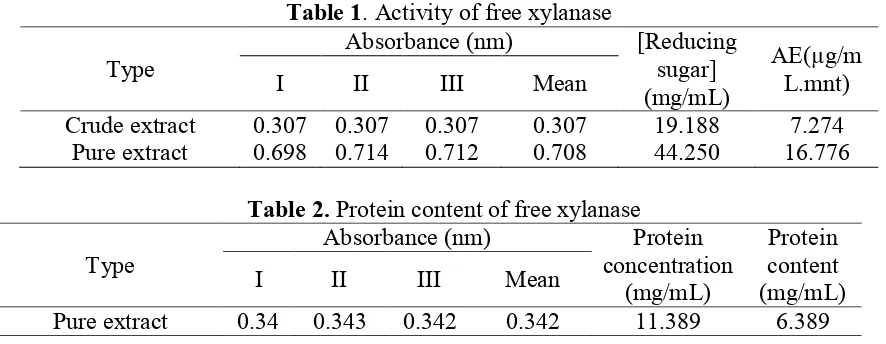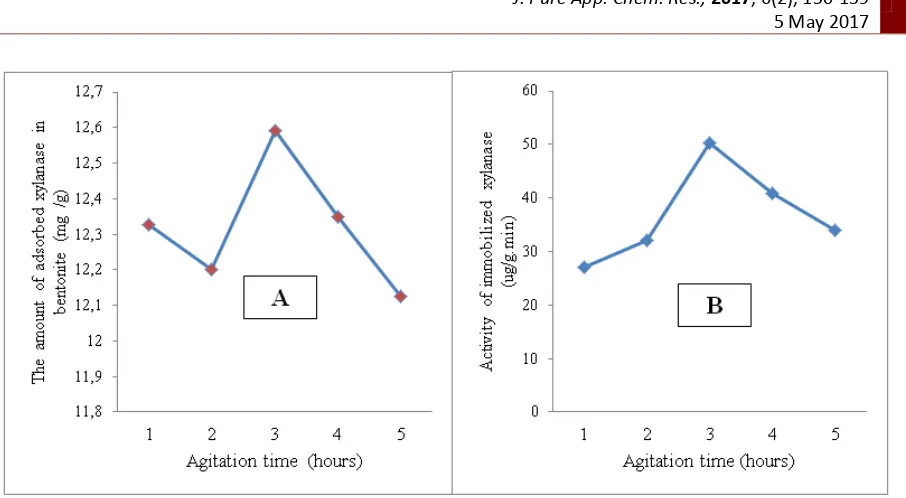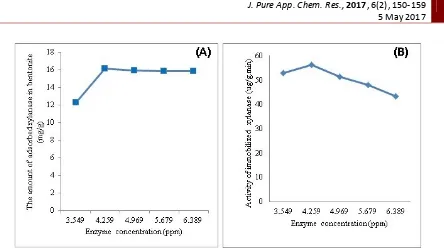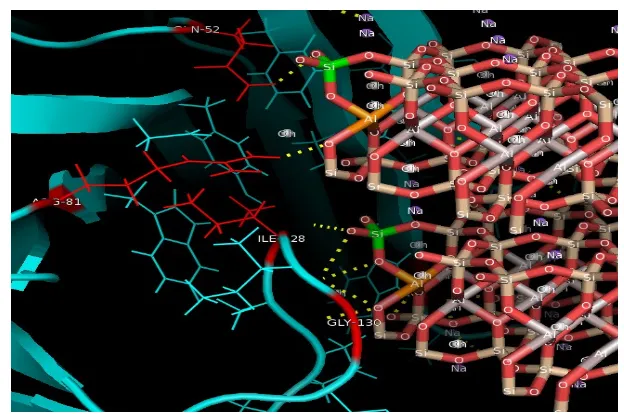The journal homepage www.jpacr.ub.ac.id p-ISSN : 2302 – 4690 | e-ISSN : 2541 – 0733
In Vitro
and
In Silico
Study of Immobilized Xylanase from
Trichoderma viride
using Bentonite Matrices Activated with HCl
Nur Lailah, Sasangka Prasetyawan, and Arie Srihardyastutie*
Chemistry Department, Faculty of Mathematics and Natural Sciences, University of Brawijaya, Jl. Veteran 65145 Malang, Indonesia
*
Corresponding author : [email protected]
Received 28 March 2017 ; Revised 1 May 2017 ; Accepted 2 May 2017
ABSTRACT
The purpose of this study was aimed determine the optimum conditions of agitation time and concentration of immobilized xylanase by in vitro and in silico and efficient reuse of immobilized xylanase. The results of in silico test showed that xylan bounded on the residues of xylanase active site through hydrogen bonding with the amino acid glutamic 177A, glutamate 86A, tyrosine 88A, arginine 122A, and glutamine 136A, whereas bentonite and the residues of xylanase active site form hydrogen bonding with the amino acid glutamine 52, arginine 81, isoleucine 128 and glycine 130. The results of in vitro
study showed that the optimum condition of xylanase immobilization was achieved at agitation time of 3 hours with the amount of xylanase adsorbed was 12.593 mg/g bentonites and activity of 50.328 units and the concentration of immobilized xylanase of 4.259 ppm and the amount of xylanase adsorbed of 16.162 mg/g bentonites and activity of 56.362 units. The immobilized xylanase can be used as many as five repetitions with the residual enzyme activity of 60%.
Key word: xylanase, Trichoderma viride, immobilization, bentonite, molecular docking
INTRODUCTION
One of the corn waste which can be used is corn husk that containing lignocellulose. The chemical composition of the corn husk consisting of cellulose 42.3%, ash 4.16%, lignin 12.58%, and others 40.95% [1]. The waste containing lignocellulose with the aid of microorganisms can produce extracellular enzymes which capable of degrading materials containing lignocellulose into its constituent fractions. One of the extracellular enzymes produced is xylanase which can hydrolyze xylan (hemicellulose) into xylose. The use of xylanase enzyme in the hydrolysis process in the industry is a new prospect in handling the hemicellulose waste. Microorganisms such as fungi, bacteria, and yeast can produce xylanase enzyme. One of the microorganisms that produces xylanase enzyme is Trichoderma viride [2].
enzyme can be reused which reduce the operating cost and increase the stability of the immobilized enzyme. The selection of immobilization technique is based on the matrix used.
Bentonite matrix has the high ion exchange capacity, the ability to expand with a layered structure and has cations which can be exchanged. The adsorption method of binding on the carrier physically has the advantage that the enzyme is not denatured and media can be reused. The capacity of bentonite adsorption is limited. These limitations can be overcome through the activation process by acid including HNO3, H2SO4 and HCl [10]. The activation of bentonite with acid will produce active sites and has a larger surface acidity resulting bentonite with higher adsorption capacity than bentonite which not activated [9]. In the current research, xylanase enzyme will be immobilized on bentonite matrices that have been activated using HCl, in order to reduce its alumina content.
Sari, Sutrisno, and Prasetyawan (2014) reported the results of the optimization of xylanase immobilization from Tricodherma viride using zeolite matrix activated with HCl with physical adsorption method. The optimum time was 3 hours with the amount of xylanase adsorbed was 7.370 mg and the activity of xylanase immobilized of 22.67 units and the optimum concentrations of immobilized xylanase of 3.366 mg/mL with amount of xylanase adsorbed of 15.65 mg/g with xylanase activity of 25.74 units. The immobilized enzyme can be used as many as five times with efficiency of 51.58 % [11].
In physical adsorption, the agitation is very influential because agitation times and enzyme concentrations affect the adsorption rate and the mass of enzyme adsorbed therefore will affect the activity of the immobilized enzyme. Furthermore, in silico study is necessary to perform in order to determine the level of the complex structure stability and strength of the bonding between enzymes, substrate and matrix (bentonite) by simulating the interaction between the active site of the receptor (enzyme), the ligand (substrate) and the matrix. The simulation of molecular interaction using in silico test (Molecular Docking) is performed optimally which can be used to determine the strength level of the complex bonding formed which can determine the enzyme activity. Therefore, it is important to do research on study of in vitro and in silico on xylanase immobilization of Trichoderma viride using bentonite matrices activated with HCl.
EXPERIMENT
Chemicals and instrumentation
All reagents were purchased from Merck, Sigma, or Smart Lab. The materials used in this study include: Trichoderma viride, dextrose, oleic acid, iron(III) chloride (FeCl3), calcium chloride (CaCl2), boric acid (H3BO3), zinc sulfate (ZnSO4), copper(II) sulfate pentahydrate (CuSO4.5H2O), potassium sodium tartrate (KNA-tartrate), barium chloride (BaCl2), ammonium sulfate ((NH4)2SO4)), magnesium sulfate heptahydrate (MgSO4.7H2O), potassium dihydrogen phosphate (KH2PO4), sodium hydrogen phosphate (Na2HPO4), glucose anhydrous, hydrochloric acid (HCl), sodium chloride (NaCl), potassium hydroxide (KOH), nitric acid (HNO3), ammonium chloride (NH4Cl), potassium hydrogen phosphate (K2HPO4), dinitrosalisilat acid (DNS), acetic acid (CH3COOH) 1.05 g/mL, sodium acetate (CH3COONa), and natural bentonite.
Production and isolation of xylanase
Liquid media (65 mL) was taken with pipette and transferred into erlenmeyer and was added using 25 g of substrate and was sterilized by autoclaving at pressure of 15 psi and temperature of 121 °C for 15 minutes. Furthermore, the inoculum (10 mL) was added into solution and was performed in laminar air flow.The mixture solution was incubated for 60 hours at room temperature and was shaken using shaker at 100 rpm. After that, solution of acetate buffer pH 5 (30 mL) was added into mixture solution and then was centrifuged in cold conditions at speed of 3000 rpm for 30 minutes at 4 °C. Supernatant containing xylanase crude extract was purified by 40-80% (NH4)2SO4 and was dialyzed using a semi-permeable membrane pouch (cellophane). The crude extract of purification was tested for its enzyme Whatman paper no. 40 to separate between filtrate and immobilized xylanase. The sediment was tested for its enzyme activity, and filtrate was tested for its protein content.
Determination of optimum xylanase concentration
The immobilization procedures at various xylanase concentrations were similar to the immobilization procedures at various agitation times. The difference was on the additional of xylanase volume used (2.5, 3, 3.5, 4 and 4.5 mL) to obtain 5 enzyme concentrations (3.549, 4.259, 4.969, 5.679, and 6.389 mg/mL).
Determination of activity of immobilized xylanase
Determination of activity of immobilized xylanase was performed with 1% xylan substrate (0.2 mL) which heated at temperature of 60 ºC for 15 minutes and was added using immobilized xylanase (0.1 grams), water-free reductant (0.2 mL), and acetate buffer pH 5(0.2 mL). The solution mixture was incubated at 50 ºC for 55 minutes, and then was heated for 15 minutes in boiling water. The mixture was filtered and the precipitate obtained was added by DNS reagent (0.4 mL) and was heated in boiling water for 15 minutes. After that, the solution mixture was diluted using distilled water until volume 10 mL and was measured the absorbance at the maximum wavelength.
Determination of reuse efficiency of xylanase
Molecular Docking
PyRex and PatchDock program were used to visualize interaction among xylanase, bentonite and xylan. Protein and ligand were downloaded from the website protein data banks (pdb) and were inserted into Pyrex-Autodock-Vina 8.0 program. In this study, a rigid docking protocol was considered in order to reduce the computational cost and time in which the receptor was kept rigid and ligands were allowed to rotate. The size of the grid box was set to 25 Å x 25 Å x 25 Å (x, y and z).The docking results were saved after the table has emerged which consists of bond energy or binding affinity and RMSD values. PyMOL program was used to view complex in 3D. Docking begins with uploading the receptor and ligand molecule.
RESULT AND DISCUSSION
Isolation and purification of xylanase from Trichoderma viride
Isolation result of pure extract of Trichoderma viride was dark yellow. Table 1 and 2 show the results of enzyme activity and protein content tests of free xylanase.
Table 1. Activity of free xylanase
Based on Table 1, the xylanase of purification result had specific activity of two times higher than the crude extracts. Based on Table 2, it can be seen that the protein content of pure extract is equal to 6.389 mg/mL. By in vitro, xylan will be bounded on xylanase active side of aspartic acid and glutamic acid . Then, xilan will be converted into xylose. The type of bond that happened between xylan and xylanase can by tested by in silico (molecular docking) using Autodock-Vinawizard 8.0 program. The xylanase protein receptor is downloaded from the bank data protein (PDB) with 3AKT code and xylan ligand with 1KNM code.
Figure 1. Interactions between xylanase with xylan
Note: xylanase ( ), amino acids( ), xylan ( ), hydrogen bonding (---) RMSD 0,0 Å; ΔG°-7 kcal/mol
Figure 2. The interaction model of complex xylanase enzyme molecules with xylan ligands Note: Glu, Tyr, Arg, Gln are abbreviation of amino acids
Determination of optimum condition of time agitation and enzyme concentration on immobilization
Figure 3. Influence of agitation time on the amount of adsorbed enzyme (A) and enzyme activity (B)
Figure 3 (A) show that the amount of adsorbed enzyme was affected by time agitation. On the addition of time agitation from 1 to 3 hours, the amount of adsorbed enzyme increased significantly. Increase the agitation time cause higher interaction between the bentonite and xylanase. This is because xylanase can be attached to bentonite surface longer. In contrast, the addition of 4 to 5 hours caused decline in the amount of adsorbed xylanase significantly. This is possible due to the desorption process, therefore, the amount of xylanase adsorbed decreased.
Based on Figure 3 (B), enzyme activity increased on agitation time 1 to 3 hours. The optimum enzyme activity was at time of 3 hours, which amounted to 50.328 units. The increase in the activity of enzymes associated with the amount of more substrate binding to xylan xylanase. This was because the amount of adsorbed xylanase on bentonite increased so that its activity was also higher.
Figure 4. Influence of enzyme concentration on the amount of adsorbed enzyme (A) and enzyme activity (B)
Based on the Figure 4 (A), it can be seen that increasing the concentration of xylanase caused increasing the amount of adsorbed xylanase. The optimum xylanase concentration was 4.259 ppm (3 mL) with amount adsorbed xylanase of 16.162 mg/g of bentonite. The increase was due to the difference in chemical potential on the surface of the bentonite matrix which caused high diffusion rate therefore the mass of adsorbed xylanase increased. As a result, decrease in the amount of adsorbed xylanase on the surface of the matrices because bentonite has been saturated with xylanase, thus bentonite is no longer adsorbing xylanase. Based on the Figure 4 (B), it can be seen that increasing of enzyme concentrations from 3.549 to 4.259 ppm, and decreasing was occurred at concentration of 4.969, 5.679, and 6.389 ppm. The xylanase activity was shown on the optimum enzyme concentration of 4.259 ppm, with activity of 56.362 units. The decreasing that occurred was due to the mass desorption of absorbed xylanase. This is due to the greater amount of adsorbed xylanase so that the substrate is able to bind to the active site of the xylanase greater.
Based on the value of enzyme activity, free xylanase had enzyme activity which was much smaller when compared to the immobilized enzyme. Basically, the activity of immobilized enzyme should have lower than free enzyme. These activities can be learned through the study of using in silico molecular docking to understand the bond between xylan-xylanase and bentonite matrix, with regards of the effect of agitation times and the enzyme concentrations. Based on in silico test, the interaction between the active site of xylanase and bentonite can be illustrated in Figure 5.
A
Figure 5. Interaction between the bentonite and the side active of xylanase
Figure 6. Interactions between xylanase, bentonite and xylan
Figure 5 showed that bentonite form hydrogen bonding with the active site residues included amino acid glutamine 52, arginine 81, glycine isoleucine 128 and 130. Values of ΔG ° was -35.89 kkal/mol and Van Der Waals style was -16.42 kcal / mol. Very low ΔG ° value indicated that the xylanase-bentonite complex was very strong. Value of ΔG ° was minus, therefore the complex run spontaneously. The binding between xylanase and bentonite occur by physical adsorption based on the Van Der Waals forces. The physically adsorbed molecules are not strong bonded on the surface, and usually there was a reversible process. Therefore, it was easy to replace with other molecules [13].
were adsorbed and the formation of enzyme-substrate complexes also increased. The docking results show that the bond between bentonite and xylanase via the O atoms of SiO2 which form hydrogen bond with several active sides of amino acids on the xylanase and via the O atoms of Al2O3.The interaction of hydrogen bonding between molecules was strong enough.
Determination of reusage efficiency of xylanase immobilized
Determination of reuse of immobilized xylanase was performed at the optimum condition which obtained from previous treatment by using the optimum time agitation for 3 hours and the optimum concentration of 4.259 ppm. This treatment was conducted to determine how much the immobilized enzyme that can get known to test the feasibility of xylanase reuse. The results of xylanase re-used were shown in Table 3. Based on Table 3, it can be seen that the enzyme activity on the reuse efficiency decreased after the first use. The reason was possible due to the strength of the bentonite matrix reduced which caused the enzyme easily detaching and can caused by the Van der Waals forces and ionic bonds between hydrogen ion of bentonite and RNH3+ of the enzyme.
Table 3. Effect of reuse to the activity of enzyme immobilized in optimum condition Repetition Enzyme activity Efficiency (%)
1 46.063 100 mg/mL. This indicates that the more detached protein contents caused less bonding between the enzyme and the substrate contained in the surface of the bentonite matrix and caused caused the enzyme activity in reuse decreases. Based on the results of study, the immobilized enzyme using bentonite matrix activated HCl can be used as many as 5 times with efficiency of 60%. The immobilized enzyme was effectively used when its activity was still above 50%.
CONCLUSION
REFERENCES
[1] Ginting, A., Dinamika Kerajinan dan Batik, 2015, 32(1), 51-62.
[2] Hatrich, D., Nidetzky, B., Kulbe, K.D., Steiner, W. and Zupaneie, S., Bioresour Technol, 1996, 58, 137-161.
[3] Sharma, M. and Kumar, A., Br Biotechnol J., 2013, 3(1), 1 – 28. [4] Harris, A. D. and Ramalingam, C., J. Exp. Sci., 2010, 1(7), 1 – 11.
[5] Peter-Albert, C. F., Ajayi, A. A. and Awosika, F., Afr. J. Appl. Res., 2015, 1, 286 – 298. [6] Gilbert M., Breu C., Aguchi M. and Saddler J. N., App Biochem Biotechnol, 1992, 34,
247 – 259.
[7] Mechaly A., Belakhov V., Shoham Y. and Bassov T., Carbohydr Res, 1997, 304, 111 – 115.
[8] Salamah, A., Roosdiana, A., & Sutrisno, Jurnal Ilmu Kimia Universitas Brawijaya,
2014, 1(1), 154-160.
[9] Kumaunang, M. & Tabaga, A., Chem. Prog., 2011, 4(2), 85-88.
[10] Bath, D. S., Siregar, J. M., & Lubis, M. T., Jurnal Teknik Kimia USU, 2012, 1(1), 1-4. [11] Sari, I. P., Sutrisno, & Prasetyawan, S., Jurnal Ilmu Kimia Universitas Brawijaya, 2014,
2(1), 421-427.




